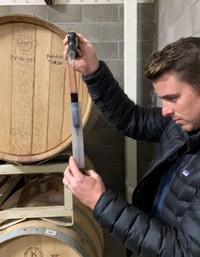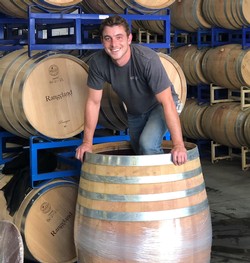Rangeland Terroir and Technique Part 2, In the Cellar
Last fall, I left off describing the barreling down of the 2021 harvest. While winter and spring are not as bustling as harvest time, there is plenty to do in the cellar “offseason.” One of the ongoing challenges in winemaking is that there are at least two vintages in the winery at any time. Currently, while the 2020 vintage is approaching bottling, the 2021 vintage needs to be tasted and blended.
The overall quality of the 2021 vintage is exceptional with ample color, texture, and depth. It’s the sort of vintage that makes any winemaker’s job easy and fun. The tricky part comes with the myriad possible blends. In prior years, we’ve waited until near bottling to complete our wine blends, but I like to blend earlier in elevage (raising and nurturing of wine). Just like slow cooking, it’s often best to get all the ingredients in early to integrate. We start this process after the wine has gone through primary fermentation (yeast converts sugar to alcohol and carbon dioxide) and malolactic fermentation (bacteria converts malic acid into softer lactic acid), roughly a few months after harvest. I then use a minimal addition of sulfur dioxide to prevent oxidation and browning of the wine before I begin racking and blending.
Racking is the process of using gravity and inert gas pressure to move wine from barrel, off its fine lees (sediment). In this case, we are racking to a tank to blend varieties or lots. Then we transfer the wine back to barrel to integrate and age. Early racking aids in retaining fresher aromatics and a softer texture. Lees may have some complex aromatics but can also hold onto some grippier tannin. I use racking on a case-by-case basis; for example, “bigger” varieties such as Petit Verdot can improve with softer tannin, while some of the complexities of a lighter Grenache sitting on lees are best left alone.
 We begin the blending process by tasting every barrel of wine; roughly 60 barrels. I take notes on which wines work best with the newer barrels. If I don’t like the taste of a particular barrel on a wine, I can switch it up after racking and blending. About 25% of our barrels are new and can add sweet tannin and toasty warm flavors to our wines. The other 75% of our barrels are deemed “neutral.” These barrels are depleted of oak flavors and merely used as storage vessels while allowing limited amounts of oxygen into the wines to soften tannin and allow flavors to evolve.
We begin the blending process by tasting every barrel of wine; roughly 60 barrels. I take notes on which wines work best with the newer barrels. If I don’t like the taste of a particular barrel on a wine, I can switch it up after racking and blending. About 25% of our barrels are new and can add sweet tannin and toasty warm flavors to our wines. The other 75% of our barrels are deemed “neutral.” These barrels are depleted of oak flavors and merely used as storage vessels while allowing limited amounts of oxygen into the wines to soften tannin and allow flavors to evolve.
Barrels, like grapes, are produced from many different terroirs and express a wide range of styles from various coopers. Most of ours are from France, although we have a few from eastern Europe. It takes a lot of trial and error to match the right barrels with our wine and terroir. On our full-bodied wines, we will be looking for a barrel that can bring more structure to the palate, and on our brighter wines we may want a barrel that adds richness.
It often takes ten to fifteen mock-up blends to get a single wine hitting the right notes of energy, depth, and focus while remaining representative of our terroir, the vintage, and the varieties. Since it’s my first year here at Rangeland, all possible blends are on the table. These combinations are further complicated when considering our diverse soil types. Wines like the Limestone Cabernet Sauvignon can be straightforward to blend, because the energetic limestone terroir is the focus. By contrast, the Watershed and Shepherd blends are a culmination of our top lots from different soil types within a vintage. These two wines go through the most rigorous blending process in our lineup. Limestone soils impart energy, bright fruits, and tension. Sandstone soils bring density, broad tannin, and richness to the wine. Also, due to the droughty nature of the sandstone soils, we pick earlier in those blocks, which lends seductive herbaceous and savory notes often found in classic wines. I run many of these samples by Laird, Lisa and the team to get their feedback and inform my final decisions. Generally, blending is a game of Tetris trying to bring our favorite blocks into the right fit with one another. Once we rack and blend these wines, it’s back to barrel for aging until bottling the following year.
Next time, in Part 3, I’ll cover the second year in the barrel leading up to bottling. Cheers!
Rangeland Terroir and Technique, Part 1: Harvest
We often speak of terroir and the ‘sense of place’ it brings to wine. Terroir is used to describe a particular region or site’s climate, soil, terrain, and tradition; such as the rusticity of a Northern Rhone syrah or the earthiness of a Burgundian pinot noir. Paso Robles wines are known for their fruit-forward power and structure, also the vibrancy that reflects the community that makes them. At Rangeland, we strive to craft wines that best represent this terroir of Paso Robles and our Adelaida Springs Ranch (ASR), but it’s a complex story.
Our ASR estate vineyard contains several soil types, slopes, and elevations that make it challenging to harvest. Our lowest elevation blocks of grapes are planted in droughty sandstone soils that ripen early--a rarity in Paso Robles. Sandstone brings broad-shouldered structure to the wines, as well as considerable depth and power. The highest elevation blocks contain limestone soils that are typical of Paso’s westside terroir and are later ripening. Limestone wines tend towards a precise and energetic structure. The middle elevation of the vineyard is planted on a mixture of these soils and includes gravelly, stressy outcrops of serpentine. This mélange of soils requires frequent fruit sampling (for sugar and acid levels) and tasting. To pick the grapes at optimum ripeness, harvesting often takes multiple hand-picked passes within a single block.
 Once the fruit is in the winery, we strive to preserve authentic terroir by practicing minimal intervention winemaking. You might say we shepherd rather than make the wine. First, the fruit is carefully sorted across a vibrating table to remove raisins, then mostly machine destemmed prior to fermentation. For Rhone varieties like syrah and grenache, we sometimes include stems in “whole cluster” lots to add aroma, tannic structure and complexity to the wine. Prior to fermentation, we stomp the grapes or lightly tread on them, breaking breakiing most of the grape skins to get some juices flowing for our cold soak. Although stomping may sound old-school and inefficient, leaving some of the berries unbroken or whole will encourage more aromatic complexity and refined textures. No need to overwork the grapes; we let them speak for themselves.
Once the fruit is in the winery, we strive to preserve authentic terroir by practicing minimal intervention winemaking. You might say we shepherd rather than make the wine. First, the fruit is carefully sorted across a vibrating table to remove raisins, then mostly machine destemmed prior to fermentation. For Rhone varieties like syrah and grenache, we sometimes include stems in “whole cluster” lots to add aroma, tannic structure and complexity to the wine. Prior to fermentation, we stomp the grapes or lightly tread on them, breaking breakiing most of the grape skins to get some juices flowing for our cold soak. Although stomping may sound old-school and inefficient, leaving some of the berries unbroken or whole will encourage more aromatic complexity and refined textures. No need to overwork the grapes; we let them speak for themselves.
Next, cold soaking is the traditional, pre-fermentation process of coaxing color and flavor from the grapes at cool temperatures, while not extracting harsh tannins. Cold soaking also allows the native yeast, present on the grape skins in the vineyard, to develop a healthy population that is strong enough to complete fermentation. Yeast is the biological workhorse that will convert grape sugars into alcohol. We shun commercial yeasts because the native type will enhance Rangeland’s unique sense of place.
Once fermentation has commenced, usually after a couple days, we turn to delicate pump-overs to promote fragrance and minerality rather than brash opulence. Pump-overs use the juice from the bottom of the fermenting vessel to soak the floating cap of grape skins and aerate the developing wine. Throughout fermentation, we monitor sugar levels and temperature while constantly tasting for the right amount of extraction and flavor before pressing.
When the fermentation is almost complete, we drain the wine off the skins and put it into barrels to encourage oak integration. This wine is called the “free run” and is typically the softest and most aromatic portion of the fermentation. We then take the grape skins and press off the remaining “press run” wine, which will provide us with more extraction and richness. The wines then settle in barrel while completing primary (yeast) and secondary (malolactic) fermentation. Later we’ll evaluate the expression of terroir and the vintage in the next best season of the year: blending.
Keep up to date on the latest wine releases, events, and promotions and get 10% off your next order.